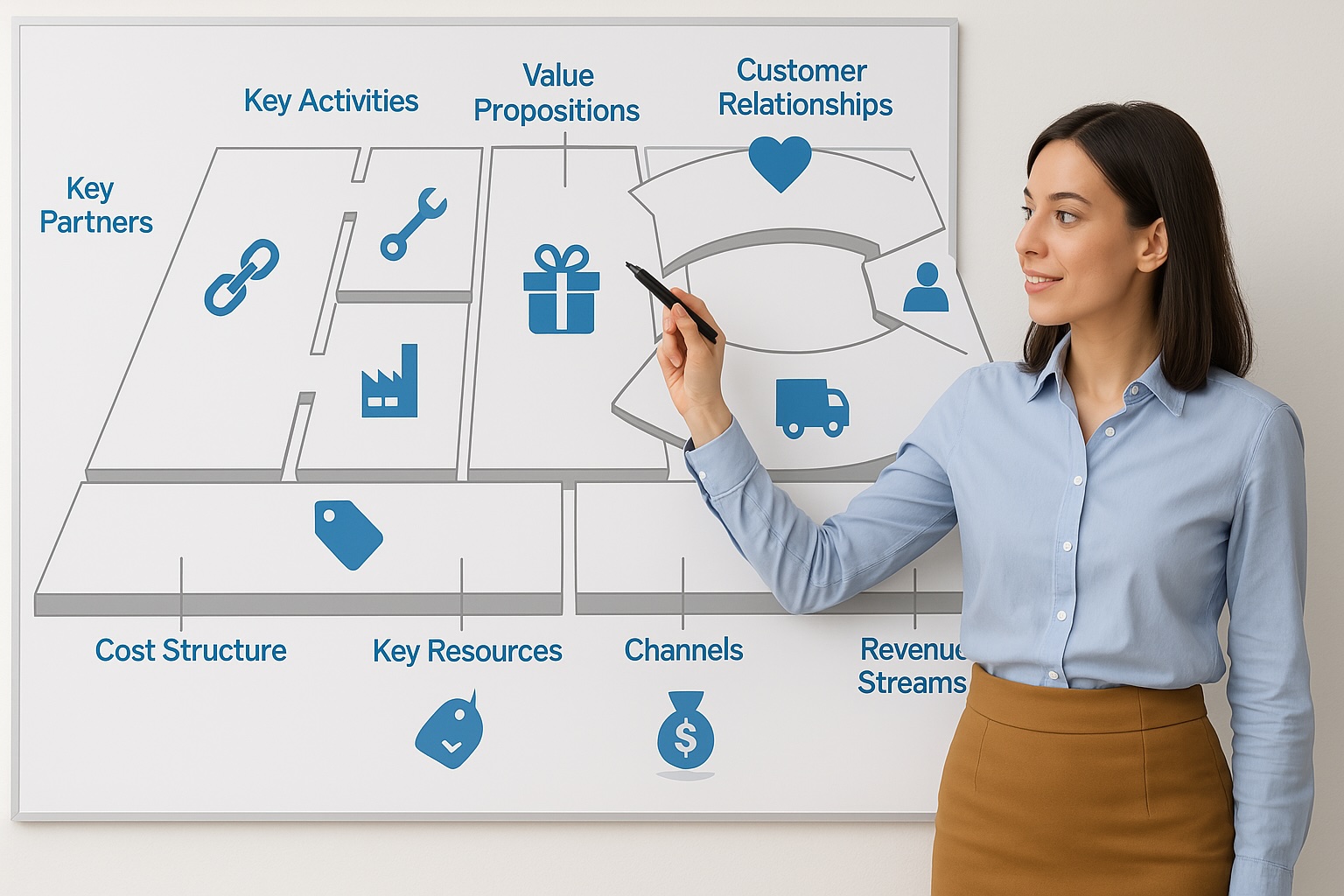Key Points
- The Business Model Canvas (BMC) is a strategic tool for designing and analyzing business models, created by Alexander Osterwalder in 2005.
- It consists of nine building blocks: Customer Segments, Value Propositions, Channels, Customer Relationships, Revenue Streams, Key Resources, Key Activities, Key Partnerships, and Cost Structure.
- Research suggests it’s effective for startups and established firms to visualize and iterate on business ideas, though its simplicity can sometimes overlook complex details.
- The evidence leans toward using it as a foundation for detailed business plans, with regular updates recommended for evolving businesses.
Introduction to the Business Model Canvas
The Business Model Canvas (BMC) is a one-page visual chart that helps entrepreneurs and businesses map out their strategy. It’s particularly useful for startups to design new models and for established companies to innovate. Created by Alexander Osterwalder, it gained popularity through his 2010 book Business Model Generation, co-authored with Yves Pigneur. This tool simplifies complex business plans, making it easier for teams to discuss and align on key aspects.
How to Use the BMC: Step-by-Step Guide
To use the BMC, start by drawing the nine blocks on a large sheet or digitally. Here’s how:
- Identify Customer Segments: Define your target customers, like health-conscious individuals for a fitness app.
- Define Value Propositions: List what problems you solve, such as personalized workout plans.
- Map Channels: Decide how to reach customers, like via an app store or social media.
- Establish Customer Relationships: Plan interactions, such as self-service through the app.
- Outline Revenue Streams: Consider subscriptions or ads, like monthly fees for the app.
- List Key Resources: Identify needed assets, like developers and servers.
- Detail Key Activities: Include app development and marketing.
- Identify Key Partnerships: Consider partnerships with wearable device makers.
- Analyze Cost Structure: Calculate fixed costs (salaries) and variable costs (marketing), aiming for cost optimization.
Iterate by discussing each block, ensuring alignment, and update as needed. Tips include focusing on partnerships for unique offerings and regularly reviewing costs against revenue.
Real-World Examples
Take Uber: Its customer segments include riders and drivers; value proposition is convenient, affordable rides; channels are the mobile app; revenue comes from ride commissions and surge pricing; key resources include the technology platform; and key activities involve driver recruitment and app maintenance. Similarly, Airbnb serves hosts and guests, offering unique accommodations via its platform, with revenue from service fees and key partnerships with local governments.

Benefits and Unexpected Insights
The BMC’s simplicity aids communication and iteration, but an unexpected insight is its potential to overlook partnerships or underestimate costs, requiring regular updates. It’s particularly effective for startups to test ideas quickly and for established firms to innovate, serving as a foundation for detailed business plans.
Detailed Analysis and Implementation Notes
The Business Model Canvas (BMC) is a strategic management and entrepreneurial tool designed to visualize, design, and innovate business models on a single page. Created by Swiss entrepreneur Alexander Osterwalder, based on his 2005 PhD work supervised by Yves Pigneur, it was popularized in the 2010 book Business Model Generation (Business Model Generation: A Handbook For Visionaries, Game Changers, and Challengers). This framework has become a staple in business schools and is used by startups and established firms worldwide for its simplicity and effectiveness in aligning activities and illustrating potential trade-offs.
Detailed Breakdown of the Nine Building Blocks
The BMC consists of nine interconnected blocks, each representing a critical aspect of a business. Below is a detailed description based on Osterwalder and Pigneur’s 2010 book, ensuring a comprehensive understanding for implementation:
| Building Block | Description | Examples/Details |
|---|---|---|
| Customer Segments | Identifies which customers the company serves, segmented by needs and attributes. | Types: Mass market (e.g., car), Niche market (e.g., Rolex), Segmented (by gender, age, income), Diversify, Multi-sided platform/market (e.g., credit card company serving holders and merchants). |
| Value Propositions | Collection of products/services meeting customer needs, distinguishing from competitors. | Provides value through: newness, performance, customization, “getting the job done”, design, brand/status, price, cost reduction, risk reduction, accessibility, convenience/usability. Types: Quantitative (price, efficiency), Qualitative (customer experience, outcome). |
| Channels | Delivers value proposition to targeted customers, ensuring fast, efficient, cost-effective distribution. | Own channels (store front), Partner channels (major distributors), or combination of both. |
| Customer Relationships | Type of relationship created with customer segments for acquisition, retention, and revenue growth. | Forms: Personal assistance, Dedicated personal assistance, Self-service, Automated services (e.g., Amazon book suggestions), Communities, Co-creation. |
| Revenue Streams | Ways a company makes income from each customer segment. | Types: Asset sale (e.g., retail), Usage fee (e.g., UPS), Subscription fees (e.g., Netflix), Lending/leasing/renting, Licensing, Brokerage fees, Advertising. |
| Key Resources | Necessary resources to create value for the customer, considered assets to sustain the business. | Human, financial, physical, intellectual. |
| Key Activities | Most important activities in executing a company’s value proposition. | Example: Bic creating an efficient supply chain to drive down costs. |
| Key Partnerships | Relationships to optimize operations and reduce risks, focusing on core activity. | Buyer-supplier relationships, Complementary alliances through joint ventures or strategic alliances between competitors or non-competitors. |
| Cost Structure | Describes most important monetary consequences of operating under different business models. | Classes: Cost-driven (e.g., low-cost airlines), Value-driven (e.g., Louis Vuitton, Rolex). Characteristics: Fixed costs (e.g., salary, rent), Variable costs (e.g., music festivals), Economies of scale, Economies of scope. |
Practical Steps for Implementation
To use the BMC effectively, follow these steps, informed by CFI’s guidance (Business Model Canvas Template | A Guide to Business Planning):
| Building Block | Tips and Steps to Consider |
|---|---|
| Key Partners | – Identify key resources received from partners. – Determine key activities performed by partners. – Assess motivation for partnership (e.g., cost reduction, unique offerings). |
| Key Activities | – List activities necessary to deliver value proposition. – Identify activities differentiating from competitors. – Evaluate impact on revenue streams, channels, and customer relationships. – Consider procurement of niche resources or cost streamlining. |
| Key Resources | – Define assets needed for operations and value proposition delivery. – Assess resources required for distribution channels, revenue streams, and customer relationships. – Evaluate need for significant capital or human resources. |
| Value Propositions | – Define what the company offers to customers. – Identify problems solved and needs satisfied. – Highlight how offerings differ (e.g., price, quality, design, status). |
| Customer Relationships | – Describe type of relationship (e.g., dedicated assistance, self-service). – Analyze interaction differences across customer segments. – Evaluate frequency of communication and level of support provided. |
| Channels | – Determine how value proposition is delivered. – Identify channels used to reach customer segments. – Ensure integration and cost-efficiency of supply, distribution, marketing, and communication channels. |
| Customer Segments | – Identify main focus of value proposition. – Describe most important customers (needs, preferences). – Define types of customers and target market (niche vs. mass). |
| Cost Structure | – List key costs and major cost drivers. – Analyze how key activities and resources contribute to costs. – Relate costs to revenue streams. – Assess utilization of economies of scale and proportion of fixed/variable costs. – Determine focus on cost-optimization vs. value. |
| Revenue Streams | – Identify multiple methods of generating revenue. – Define pricing strategy for products. – Specify payment channels and options (e.g., up-front, payment plans, financing). |
For example, to create a BMC for a hypothetical fitness app, start by identifying customer segments (health-conscious individuals aged 18–35), defining value propositions (personalized workout plans), and mapping channels (app store, social media). Outline revenue streams (monthly subscriptions), list key resources (developers, servers), detail key activities (app development, marketing), identify key partnerships (wearable device makers), and analyze cost structure (fixed costs like salaries, variable costs like marketing). Iterate by discussing with the team, ensuring alignment, and update as the business evolves.
Real-World Applications and Examples
Real-world examples illustrate the BMC’s versatility. For Uber, detailed in Product Compass (Business Model Canvas Examples: Google Maps, Airbnb, Uber), the canvas includes:
| Block | Details for Uber |
|---|---|
| 1. Key Partners | Drivers, fleet operators, payment processors, regulatory bodies, technology providers, vehicle manufacturers. |
| 2. Key Activities | Platform development, marketing, customer support, regulatory compliance, driver recruitment. |
| 3. Key Resources | Technology platform, user data, brand reputation, human resources, financial resources. |
| 4. Value Propositions | Convenience, availability, affordability, safety, variety (e.g., UberX, UberPOOL). |
| 5. Customer Relationships | Self-service via app, 24/7 support, ratings/reviews, personalization. |
| 6. Channels | Mobile app, website, social media, email marketing, partnerships. |
| 7. Customer Segments | General public, business travelers, commuters, tourists, drivers. |
| 8. Cost Structure | Technology costs, driver payments, marketing, customer support, regulatory costs, operational costs. |
| 9. Revenue Streams | Ride fees, surge pricing, subscription services, advertising, partnerships. |
Similarly, Airbnb serves hosts and guests, offering unique accommodations via its platform, with revenue from service fees and key partnerships with local governments for regulatory compliance, as noted in various business model analyses (Business Model Canvas Explained: Examples And Structure).
Benefits, Challenges, and Tips
The BMC’s simplicity aids communication and iteration, making it effective for startups to test ideas quickly and for established firms to innovate. However, challenges include potentially overlooking partnerships or underestimating costs, as highlighted in CFI’s resources. Regular updates are recommended to keep the canvas relevant, especially as businesses evolve. Tips include focusing on partnerships for unique offerings, ensuring cost structures align with revenue streams, and using it as a foundation for detailed business plans rather than a replacement.
An unexpected insight is its adaptability to niche industries, with new canvases emerging for specific sectors, enhancing its utility beyond general business strategy. This flexibility ensures it remains a dynamic tool, particularly for digital platforms like Uber and Airbnb, which rely heavily on technology and partnerships.
Conclusion
The BMC is a powerful, flexible tool for designing, analyzing, and innovating business models, with clear steps for implementation and real-world examples demonstrating its effectiveness. By regularly updating and iterating, businesses can leverage its simplicity to align strategies and drive growth, making it an essential resource for entrepreneurs and strategists alike.


Leave a Reply